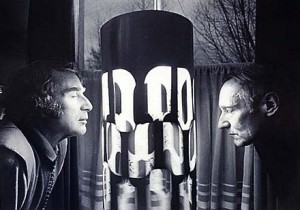Since the 1850s, sound reproduction technologies—like the ear phonautograph (1874) pictured on the right—have changed over time, with some becoming obsolete as others became cutting edge. In one sense, this course is an opportunity for you to trace that history by studying a spectrum of technologies and their sounds: everything from the phonograph and magnetic tape to the turntable and the computer.
Yet in another sense, the course is a chance to explore how those technologies are culturally embedded. For example, how have artists and writers integrated sound reproduction technologies into their work, and to what effects on other media, such as print? Through advertisements and film, how were certain technologies marketed, to whom, and for what purposes? How are sound reproduction technologies tied to questions of race, gender, class, and sexuality? When, where, and for whom does a sound seem pleasant, a recording appear high fidelity, or an environment become noisy? Or more specifically: why was a human eardrum part of this phonautograph, and what does it say about the use of human bodies for scientific progress and technological development?
No doubt, these questions—open-ended though they are—will keep us curious throughout the quarter. And during our conversations, we will also tap into some theories of listening and seeing. Here, we will unpack how listening and seeing are often situated in opposition to each other, as well as how they are attached to particular value systems. We will also determine how to critically respond to such traditions by conducting in-class listening and discussion sessions focused on various storage media (e.g., vinyl records, phonograph cylinders, cassette tapes, film, and the MP3) and the differences between them. True, we can’t hear like they did back then. But at least they left their stuff behind.
The ultimate aim of the course, then, is for you to walk away with competencies in how to approach sound reproduction as a historical, aesthetic, and political object of inquiry. So in case you are wondering: This is not a class about music. Or radio broadcasting. Sure, we will likely chat about songs, musical instruments, recording studios, live performances, and Lady Gaga. In a class about sound, how could we not? Nevertheless, the emphasis of the course rests in the inscription, circulation, and representation of sound over time.
To put those competencies into practice, each of you will create, gather, and analyze several audio recordings over the course of the quarter and remix them for your final project. I hope this project will be simultaneously fun, informative, and—at times—a challenge. More on the project and its stages below.







TrackBack URI